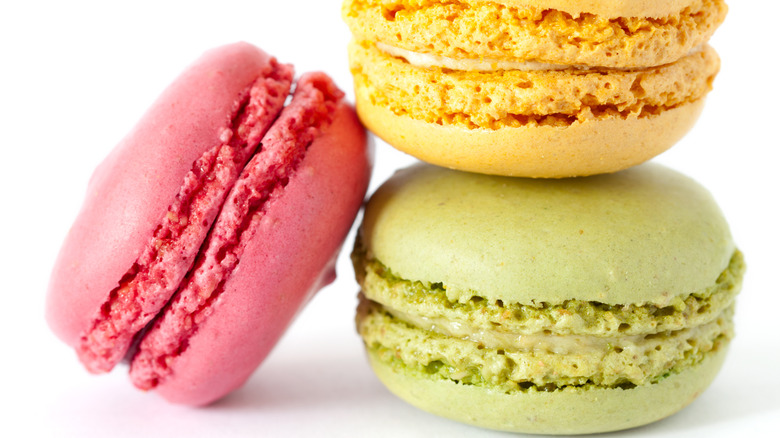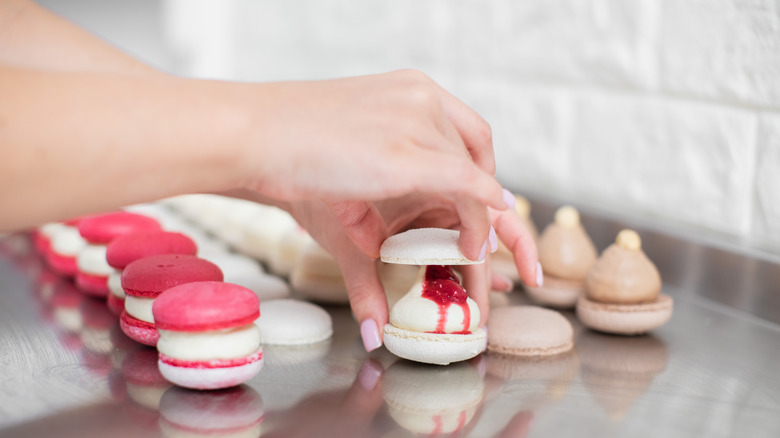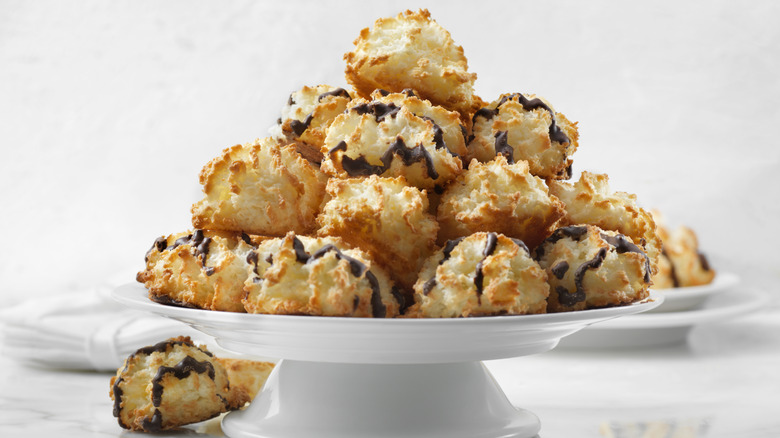What's The Difference Between A Macaron And A Macaroon?
Macarons and macaroons may be easy to confuse with each other, thanks to their near-identical names with just one extra "o" to differentiate between them. But don't get it twisted: these two sweet treats are not the same thing with different spellings.
The macaron (with one "o," pronounced "mack-ah-rohn") is a French baked good that's approximately a meringue sandwich. It consists of two small circles of baked meringue (you could probably describe them as "cookies," although some purists might argue that cookies and meringues aren't the same). They're typically sandwiched together with a layer of buttercream, creamy ganache, or jam.
The macaroon (with two "o"s, pronounced "mack-ah-roon," with an ending like "moon") is more like a fluffy cookie, made with egg white and coconut and baked, often coming out shaped like a cone or a small circular mound.
Let's get the similarities out of the way: They're both sweet and the size of a small cookie (maybe 1 to 1.5 inches in diameter). They should usually be pretty light since both use firmly beaten egg whites as a key ingredient, although macaroons are the heavier of the two. However, the way they're made is pretty distinct.
What makes a macaron?
Although macarons are seen as an ultra-French treat, they actually originate from Italy, where they were made as far back as the eighth century. They came to France in the Renaissance era, but the modern "sandwich" version was created in the 20th century in Paris — these are the kind you'll buy in fancy little boxes from famed stores like Maison Ladurée.
To make a batch of those, you'll whip some egg whites into stiff peaks (this will be a serious arm workout if you're doing it without an electric beater). Ground almonds and powdered sugar are then folded in, and the batter is piped into small circles and baked until a little crisp outside but still a little chewy inside.
Once the meringues have cooled, you'll put the filling onto the flat side of one (the side touching the baking tray) and make the sandwich-like end product. The most common fillings are ganache, buttercream, or jam, and there's nothing stopping you from experimenting with different flavors — Parisian stores are known for having all sorts of flavors, from berries to vanilla or pistachio.
And what about macaroons?
These also originated in Italy, where they were historically made with the same ingredients (egg whites, sugar, and almonds) in the Medieval period. The lack of flour meant that Italian Jews adopted these as a Passover dessert.
Fast forward to the late 19th century, and they had found their way to the Jewish-American diaspora. As dried coconut became a mass-market product, it found its way into macaroons and eventually replaced almonds, resulting in the modern macaroon. Jewish-owned department stores and food companies were big proponents of the coconut macaron, helping it take off in popularity and cementing its place as part of Jewish-American culinary culture.
Nowadays, macaroons are typically made with egg whites beaten until they're stiff. Coconut, sugar, and vanilla are then mixed in, and this batter is shaped into cones or puffs and baked until golden brown — the interior should still be a bit chewy. Some recipes may also recommend adding sweetened condensed milk, almond essence, or dried fruit or nuts. For some extra decadence, the final product can be dipped into or drizzled with melted chocolate, although this is an optional extra.


